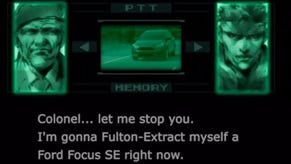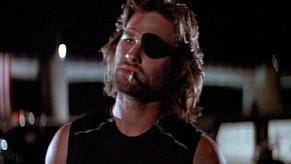Metal Gear Solid HD back-compat for Xbox One is the best way to play
But why isn't it X-enhanced?
If there's one game franchise crying out for the full current-gen remastering treatment, it's Metal Gear Solid. The classic MGS titles have remained untouched since 2011's excellent Metal Gear Solid HD collection, with no sign of any Xbox One or PlayStation 4 re-releases - despite the emergence of MGS cutscenes apparently running on the Fox Engine on a Japan-only pachinko machine, of all places. However, there is some good news: the 2011 remaster is now backwards compatible on Xbox One, and as things stand, this is easily the best way to play these brilliant games on modern hardware.
Expectations do need to be managed, however. In common with all standard Xbox 360 titles running on Xbox One, rendering resolution remains at the same 720p with 2x MSAA as Bluepoint's original remaster, and aside from additional 16x anisotropic filtering added at the system software level on Xbox One X, the overall presentation on all of the titles in the package is identical to their Xbox 360 counterparts. However, running on backwards compatibility takes a key advantage of the remasters and improves on it still further.
Of course, I'm talking about performance, where Bluepoint Games' original work attempts to run both MGS2 and its much more challenging sequel at a locked 60fps. The task facing the developer was significantly more straightforward with MGS2 in that Kojima's team targeted 60Hz gameplay for the original PlayStation 2 release. The end result is that the transition to Xbox 360 and PlayStation 3 resulted in a mostly locked frame-rate during the majority of the action. The opening tanker area with Snake is arguably the biggest stress-test you'll find in the game, with lots of geometry and rain effects. The last-gen system handle this well, and so there's no surprise that Xbox One and X both follow suit.
Cutscenes in MGS2 are a different story, however. Whether it's the hangar or the later oil rig sections with Raiden, anything showing the a wider scale playable area hammers performance on original Xbox 360 hardware. That's mostly cleared up with the back-compat releases, but one spot where this surprisingly isn't the case - and where even X struggles - is on long views of the plant chapter in cutscenes. One shot sees a harsh drop to 35fps on Xbox 360, bumped up to 48fps on the newer Xbox models. It's unusual to see no tangible increase with X hardware there, since that does seem like a more GPU-intensive scene - and even if we were CPU-limited, the X has a 31 per cent boost to performance there too. In the main though, this game runs at 60fps more solidly than any other console version, and you do get the residual benefit of 16x anisotropic filtering on X at least, if little else.
It's with the technologically more challenging Metal Gear Solid 3 where Bluepoint Games began to hit the limits of what they could achieve with their remaster on the last-gen consoles - and where current-gen hardware can make more of a difference. The original PS2 release saw Kojima's team aim to revolutionise in-game detail at the expense of trading MGS2's 60fps gameplay for 30fps instead. In fact, the implementation of this decision was rather forward-looking - while cutscenes operated with v-sync (with performance often plummeting), gameplay ran at 30fps with adaptive sync, presenting occasional, though noticeable screen-tear. Adaptive sync - especially at 30fps - was somewhat uncommon in the PS2 era, but was often deployed in the generation to follow. Overall though, MGS3 was the result of a technically brilliant development team truly pushing the PS2 to its limits in its twilight years. And for its remaster, Bluepoint aimed to bring it up to the same 60fps target as Metal Gear Solid 2 - an ambitious undertaking.
Bluepoint almost pulled it off too. In common with the PlayStation 2 original, cutscenes could often miss the target, but gameplay was generally solid enough. Perhaps ironically, bearing in mind the series' roots, the Xbox 360 remaster ran noticeably more smoothly than its PlayStation 3 equivalent, but both delivered a huge upgrade over the same game running on original hardware.
The advantage is especially pronounced in gameplay - but how smooth MGS3 runs depends very much on the version you're playing. The standard game with its default top-down view essentially delivers 30fps with just some mild dips beneath the target, accompanied by a flicker of screen-tearing. However, the later Subsistence version shipped with a freecam option that brought performance down to 20-30fps, with a lot of tearing. When it came to optimising the PS2 code, gameplay ran much smoother with this limited, fixed, bird's eye view.
For its remaster, Bluepoint didn't just take on the extra challenge of the freecam mode, but actually improved on its PS2 implementation. It can still result in some performance drops on PS3 and Xbox 360, but in common with the vast majority of frame-rate dips found in the remaster, running the game on Xbox One hardware improves the outlook considerably, though the extra GPU power of the X hardware is left largely untapped.
And this leads us on directly to the situation surrounding Xbox One X enhanced Xbox 360 games - principally, why has the flow of releases stopped so abruptly? It's been six months now since Microsoft released the second wave of titles, and since then we've seen nothing - despite a continuing flow of regular back-compat releases. And when high profile titles like the Metal Gear Solid HD Collection arrive on Xbox One, you can't help but wonder why an X-enhanced update doesn't follow suit.
In the case of these remasters, we'd be looking at a full 3840x2160 ultra HD presentation, with MSAA on top for absolutely pristine image quality. And based on the quality of Bluepoint's 720p remastering - not to mention running the original PS2 titles at native 4K via PCSX2 emulation - we can see that the artwork holds up, that this could truly be something special. Meanwhile, prior X-enhanced Xbox 360 games have also shown that this resolution bump is usually accompanied by improved performance in addition to the 9x resolution increase. Potentially stunning 4K releases of these classic titles would be astonishing but remain tantalisingly out of reach.
As we move into Q4, where the biggest new games roll out and where the platform holders are keen to shift as much hardware as possible, our hope is that the X-enhanced Xbox 360 programme is rebooted for Xbox One X owners. As things stand, the Metal Gear Solid HD collection on Xbox One is undoubtedly the best way to play these classic games - but an X-enhanced release would take these classics to the next level on today's top-tier ultra HD displays.



















